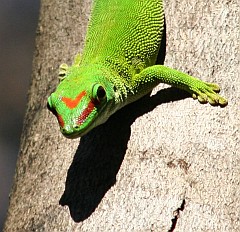
Green Day Gecko of Madagascar
|
Flora & Fauna Areas Madagascar Flora/Fauna Related Pages |
Madagascar Reptiles
This page highlights some of the reptile species of Madagascar.
With over 300 reptile species, Madagascar ranks tenth in the world for reptile diversity. But more importantly, more than 90% of those species are endemic (meaning they are found nowhere else in the world). The most studied of Madagascar's reptiles are the chameleons; the island is home to both the world's largest and the world's smallest chameleon. Geckos are also well represented, as are snakes. Amazingly, when the land mass of Madagascar broke off from Africa, none of the poisonous snakes ended up on Madagascar, which means all the snakes on the island are venom-free.
Photos are all credit Amanda Hacking, with the exception of the Leaf Gecko, the Nile Crocodile and the Boa.
Geckos
 Green Day Gecko of Madagascar |
One of the most commonly seen reptiles in Madagascar is the colorful Green Day Gecko Phelsuma Agrandis Madagascarensis (right) with its red facial bars and red markings on the lower back. Day geckos live in all forested parts of Madagascar, and are not endangered. Most geckos are tan, brown and/or black, with the exception of the beautiful Madagascar Green Day Gecko. Perhaps it is one of the most commonly seen because it is so easy to see!
Geckos are lizards, in the family Gekkonidae. There are more than 800 gecko species in the world and they are found in tropical and semi-tropical Asia, Africa, Madagascar, South and Central America and many oceanic islands. They have broad toes which you might think have sticky glue on the bottom, given that they can walk on vertical surfaces and upside down on ceilings of homes. But in fact, the bottoms of their toes are covered in bushy scales that create friction, letting them cling to even smooth slippery surfaces. Most lizards are silent except for a hissing sound. Geckos make a clicking sound that gave them their name "gecko". Geckos' eyes are covered by a thin transparent membrane. To keep this membrane clean, they lick it with their thick and sticky tongues. Geckos live in tropical and semi-tropical parts of the world. They lay 2 white eggs. Their diet consists of insects, and they are often found in homes where they are assured of a variety of household insects to eat.
Chameleons
Chameleons are also lizards, in the family Chamaeleontidae. World-wide there are about 85 species found in Africa, Madagascar, southern Asia and southern Europe. Madagascar alone is home to 50 of those 85 species giving it more than any where else in the world. The most striking feature of these relatively small lizards, is that they can change color. In response to fear, temperature or environment their body produces hormones which change the pigment in the cells of their skin. While it is popularly thought that they change color to match their surroundings, it is not always the case. Chameleons feed on insects which they catch with their long sticky tongue. The tongue is kept retracted in the mouth until it is shot forward at incredible speed to strike its prey. The chameleon's two eyes operate independently of each other, allowing it to search for prey (and watch for predators) in many directions at once. Once it sees a tasty insect it brings both eyes to focus on the animal so that it gets excellent depth of field for good aim. Chameleons are well adapted to living in trees, being able to raise their bodies up to move about, to grasp branches with their strong tails and their specialized feet that have 3 toes opposing 2 (which is called zygodactylism).
 |
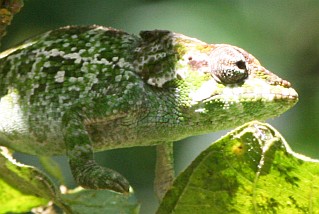 |
The lovely small chameleon, Caloma Ambre is found in the deep rainforests in Montagne d'Ambre National Park in northern Madagascar. While in the sun, on a finger, it displayed very pale coloring, but once returned to the shade of a bush it quickly began to change so that it was camouflaged in the darker shadows. The animal on the left shows a typical foot with the 3 toes opposing 2. (see below) |
 |
High in the rainforest of Montagne d'Ambre National Park in northern Madagascar we found the world's smallest chameleon, the Dwarf Chameleon, Brooksia minima. Our guide, Arnaud, sifted through the leaf litter at the base of a hardwood tree, and within a few seconds came up with this little fellow which fit easily in his hand. Unlike other chameleons, the Dwarf Chameleons don't change color, but are always dark brown. These small chameleons are no more than 2.5 cm (1 in). Click on the picture to see how small it is, compared to the hand it's in. |
| The large Panther Chameleon (right) is a common resident in the forests of Madagascar. Here, you can see one with eyes closed. Note the claws on the feet which are not in contact with the tree branch. Claws are not used for grasping branches because chameleons have zygodactylius feet, meaning they have three toes opposing two (and 2 toes opposing 3 on their back feet). This allows them to hold onto things, much like humans do with thumb and fingers. |
 |
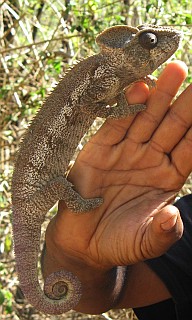 |
|
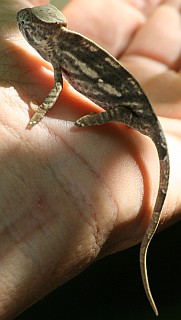 |
||
|
Other Reptiles
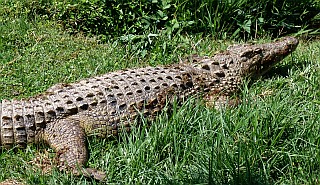 |
The Nile Crocodile Crocodylus niloticus (left) is the one crocodile species found in Madagascar. Crocodiles live in rivers throughout the island, and are even found in some subterranean rivers in the Réserve Spéciale de l'Ankárana in northern Madagascar. Nile crocodiles are the second largest crocodile species in the world, (the largest are in Australia) reaching more than 3m (10ft). Crocodiles are aggressive hunters and will take humans who wander to the river edge, or zebu (Madagascar cattle), or smaller prey. At Lac Antanavo in northern Madagascar, crocodiles are considered sacred. The people there believe the crocodiles contain the spirits of ancestors who were killed near the lake. |
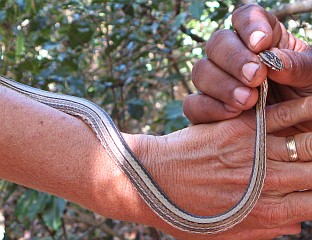 |
|
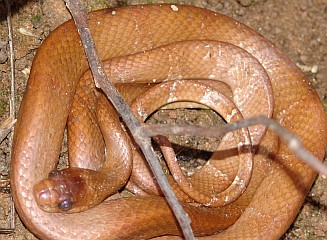 |
||
|
Top Level: Home | Destinations | Cruising Info | Underwater | Boat Guests | Ocelot | Sue | Jon | Amanda | Chris | Site Map | Make a Comment
|
If our information is useful, you can help by making a donation |
Copyright © 2000‑ Contact: Jon and Sue Hacking -- HackingFamily.com, svOcelot.com. All rights reserved.